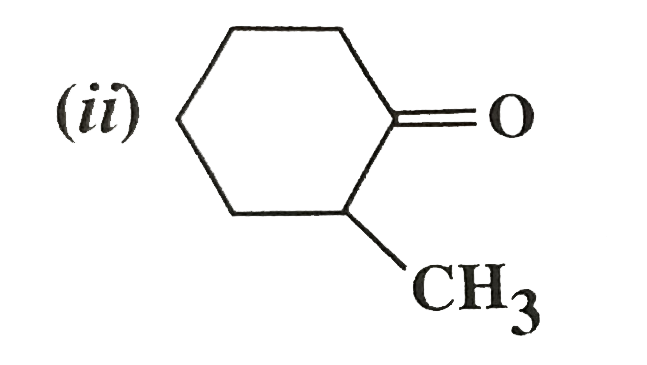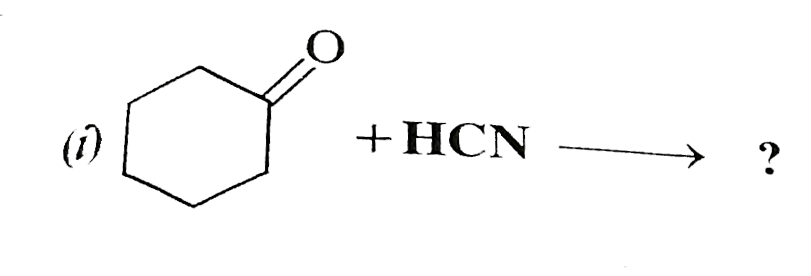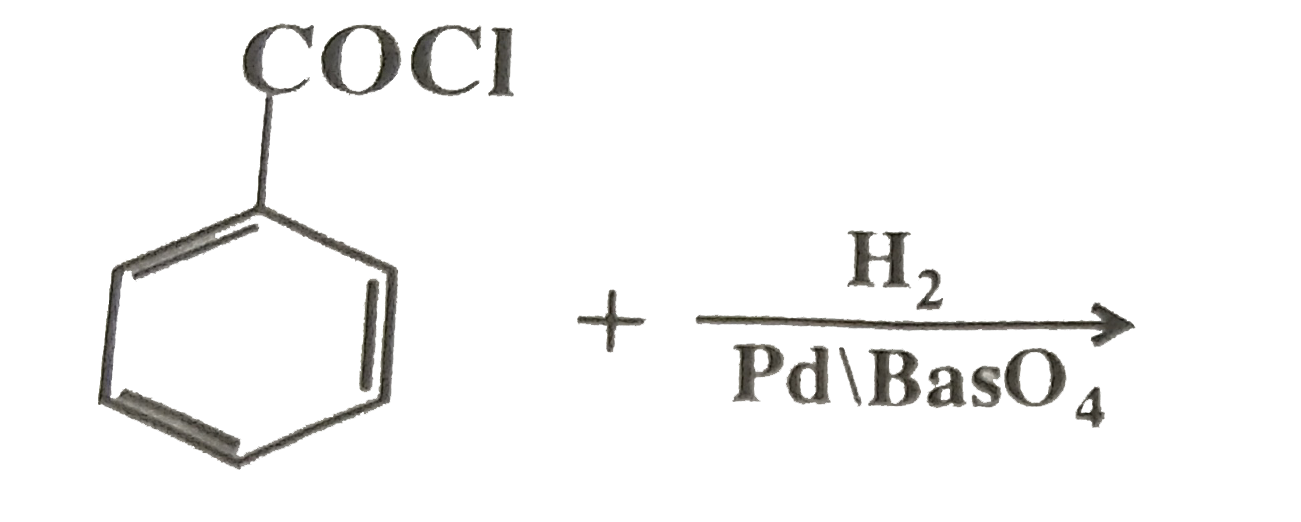Complete Solutions to Question From Board of chapter ALDEHYDES AND KETONES of Class 12 book with complete answers and questions
| Class 12 | CHEMISTRY |
| Chapter | ALDEHYDES AND KETONES |
| DINESH COMPANION CHEMISTRY | Question From Board |
| Number Of Questions | 86 |
| Academic Year | 2023-24 |
What happens when ethylbenzene is heated with acidified `K_(2)Cr_(2)O_(7)` ?
View SolutionWhy are aldehydes more reavtice than ketones towards nucleophilic addition reactions ?
View SolutionConvert acetone to teriary butyl alcohol?
View SolutionWhat is Tollen's reagent?
View SolutionHow are formalin and trioxane related to methanal?
View SolutionWrite chemical equation to illustrate Rosenmund's reduction.
View SolutionHow will you perpare ethlamine from acetaldehyde ?
View SolutionHow will you convert ethanol to propanone ?
View SolutionGive a chemical test to distinguish between benzaldehyde and acetone.
View SolutionGive a chemical test to distinguish between methanol and ethanol.
View SolutionWrite IUPAC name of the compound `CH_(3)-underset(CH_(3))underset(|)(CH)-CO-underset(CH_(3))underset(|)(CH)-CH_(3)`.
View SolutionWrite a test to differentiate between pentan-2-one and pentan-3-one.
View SolutionHow will you convert acetaldehyde into methane?
View SolutionWrite IUPAC name of the compound : `CH_(3)COCH_(2)COCH_(3)`.
View SolutionWrite the chemical equation for each of the following reactions :
(i) Rosenmud's reduction (ii) Cannizzaro's reaction.
View SolutionHow will you convert ethanol to propanone ?
View SolutionComplete the followning :
(i) `CH_(3)COCH_(3) + HI overset("Red"P//423K)rarr`
(ii) `CH_(2)=CH_(2) + PdCl_(2) + H_(2)Ooverset(CaCl_(2))rarr`
View SolutionComplete the following with appropriate reagents

View SolutionHow many asymmetric carbon atoms are created during the complete reduction of benzil `(PhCOCOPh)` with `LiAlH_(4)`? Also wrie the number of possible stereoisomers formed as the product.
View SolutionComplete the following
(i) `3(CH_(3))_(2)C = Ooverset([A])rarr`
(ii) `CH_(3)COCl+H_(2) overset([B])rarr`
(iii) `[C] overset(NH_(2)//NH_(2))underset(C_(2)H_(5)Ona)rarrCH_(3)CH_(2)CH_(3)`
View SolutionHow will convert 2-Methyllpent-2-enal to
(a) 2-Methypentane , (b) 2-Methylpentanal?
View SolutionName the reagent that can be used to convert
(i) A primary alcohol to an aldehyde
(ii) Butan-2-one to butan -2-ol.
View SolutionWhy are lower members of aldehydes easily miscrible with water?
View SolutionGive a test to distinguish between proponal and propanone.
View SolutionWrite the IUPAC name of the following compound :
`H_(3)C-overset(Cl)overset(|)(CH)-CH_(2)-overset(O)overset(||)(C)-CH_(3)`
View SolutionWrite IUPAC name of `CH_(3)-underset(Br)underset(|)CH-underset(CHO)underset(|)(C)H-CH_(3)`
View SolutionWhat happens when methanal is treated with methyl megnesium bromide and then hydrolysed?
View SolutionComplete the following
(i) `CH_(3)-underset(CH_(3))underset(|)overset(CH_(3))overset(|)C-OH underset(H_(2)SO_(4))overset("heat")rarr?underset(("Ozonolysis"))overset(O_(3))rarroverset(H_(2),Ni)rarr?`
View SolutionGive the structure of 3-Oxopentanal.
View SolutionHow will you prepare benzaldehyde from toluene?
View SolutionWrite the structural formula of 1-Phenlpentan-1-one.
View SolutionWrite the chemical equation for each of the following reactions :
(i) Rosenmud's reduction (ii) Cannizzaro's reaction.
View SolutionHow will you convert cyclohexanol to cyclohexanone?
View SolutionGive IUPAC name of the organic compound : `(CH_(3))_(2)=CH-overset(O)overset(||)(C)-CH_(3)`.
View SolutionWrite the chemical equations for the following conversions (in not more than `2` steps)
(i) Acetaldehyde to butane-1,3-diol , (ii)Acetone to propene
View SolutionComplete the following reactions by identifying A,B and C.
(i) `A + H_(2)(g)overset(Pb//BaSO_(4))rarr(CH_(3))_(2)CHCHO`
(ii) `CH_(3)-overset(CH_(3))overset(|)underset(CH_(3))underset(|)(C)-underset(O)underset(||)C-CH_(3)+NaOIrarrB+C`
View SolutionHow would you prepare but-2-enal from ethanol?
View SolutionDraw structure of 4-Chloropentanal.
View SolutionGive a simple test to distinguish between :
(i) Pentan-2-one and Pentan-3-one. , (ii) Benzaldehyde and acetophenone.
View SolutionGive the names of reagents which can bring about the following conversions :
(i) Propane-1-ol to propanal.
(ii) Pent-3-en-2-ol to pen-3-en-2-one.
View SolutionHow wil l you convert ethyl cyanide to 1- phenylpropanone?
View SolutionArrange the following compounds in increasing order of their reactivity in nucleophilic addition reactions.
(i) Ethanal, Propanal, Propanone, Butanone.
(ii) Benzaldehyde, p-Tolualdehyde, p-Nitrobenzaldehyde, Acetophenone.
Hint: Consider steric effect and electronic effect.
View SolutionGive a simple test to distinguish between :
(i) Pentan-2-one and Pentan-3-one. , (ii) Benzaldehyde and acetophenone.
View SolutionIllustrate Cross-aldol condensation with a suitable example.
View SolutionWrite the structures of the main products of the following reactions.
` `
`
View SolutionWrite the IUPAC name of
`CH_(3)-CH_(2)-CH=CH-overset(O)overset(||)(C)-H`
View SolutionWrite the IUPAC name of the following
(i) `(CH_(3))_(2)CHCHO` , (ii)
View SolutionComplete the following
`2CH_(3)CHOoverset("Dil NaOH")rarrAunderset(-H_(2)O)overset("heat")rarrB`.
View SolutionWhat happens when :
(i) Acetaldehyde reacts with `NH_(2)OH` , (ii) Acetone reacts with `NH_(2)-NH_(2)`.
View SolutionArrange the following compounds in increasing order of their boiling points.
`CH_(3)CHO,CH_(3)CH_(2)OH,CH_(3)OCH_(3),CH_(3)CH_(2)CH_(3)`
View SolutionHow will you convert propanone to propan-2-ol?
View SolutionComplete the following reactions :

View SolutionWhy is acetaldehyde more reactive than acetone towards nucleophilic addition reactions ?
View Solution`(CH_(3))_(3) C - CHO` does not undergo aldol condensation due to
View SolutionWrite chemical equation to illustrate the following reactions:
(i) Wolff Kishner reduction , (ii) Aldol condensation
(iii) Cannizzaro reaction.
View SolutionWrite the products of the following reactions:
(i)
(ii) `2C_(6)H_(5)CHO+NaOH ("conc.") rarr`
View SolutionWrite the IUPAC name of `CH_(3)-underset(NH_(2))underset(|)CH-CH_(2)-CHO`.
View SolutionOut of `CH_(3)CH_(2)COCH_(2)CH_(3)` and `CH_(3)CH_(2)CH_(2)COCH_(3)` which gives iodoform test ?
View SolutionHow will you convert benzoyl chloride into benzaldehyde?
View SolutionComplete the following reactions
(i) `CH_(3)-overset(O)overset(||)(C)-CH_(3)overset(CH_(3)MgBr)underset("ether(dry)")rarrAoverset(H_(3)O^(+))rarrB` (ii) `CH_(3)-CH_(2)-CH_(2)-CHOoverset(Ni//H_(2))rarrA`
View SolutionAn organic compound [A], whose molecular formula is `C_(3)H_(6)O`, gives iodoform reaction and forms compound [B]. Compound [B], when heated with silver powder, converts into compound [C}. Compound [C] reacts with dil. Sulphuric acid and mercuric sulphate to obtain compound [D], which gives Aldol condensation reaction. Write down the names of all compounds from [A] to [D] and also write the chemical equations for each step.
View SolutionHow will you convert propanone to propene ?
View SolutionPredict the product of reaction ?
`CH_(3)-underset(CH_(3))underset(|)(C) = Ooverset("HCN")rarr?`
View SolutionWrite the structures of the main products when `CH_(3)CH_(2)CHO` reacts with the following reagents :
(i) `Zn-Hg//"Conc".HCl` , (ii) `H_(2)N-OH//H^(+)` , (iii)`HCN`
View SolutionDistinguish between the following :
(i) `CH_(3)-CO-CH_(2)CH_(3)` and `CH_(3)-CH_(2)-CH_(2)-CHO`
(ii) Ethanal and ethanoic acid.
View SolutionWrite the structures of A,B C and D in the following reactions :
`C_(6)H_(5)COCloverset(H_(2)//Pd-BaSO_(4))rarr[A]overset("NaOH(conc.)")rarrB+Coverset(CH_(3)MgBr//H_(3)O^(+))rarr[D]`
View Solution(a) Write the reagent used in the following :
`C_(6)H_(5)COCH_(3)overset(?)rarr C_(6)H_(5)CH_(12)CH_(3)`
(b) Arrange the following compounds in increasing order of reactivity towards nucleophilic addition.
`CH_(3)CHO, C_(6)H_(5)CHO, HCHO`
View SolutionPredict the product of the folllowing reaction :
`CH_(3)-underset(CH_(3))underset(|)C=Ooverset(H_(2)N.NHCOOCH_(2))rarr?`
View SolutionHow can aromatic aldehydes and ketones be prepared by the following reaction ?
(i) Reimer-Tiemann reaction , (ii) Friedal Craft reaction , (iii) Etard reaction.
View SolutionExplain the structure of carbonyl group.
View SolutionWrite the structures of A, B, C and D in the following reactions :

View SolutionWrite the product of the following reaction.
`CH_(3)CH_(2)CH=CHCH_(2)CNoverset((i) ("di-isobutyl")_(2)AlH)underset((ii) H_(2)O)rarr`
View SolutionA and B are functional isomers of compound `C_(3)H_(6)O`. On heating with `NaOH` and `I_(2)` isomer A froms yellow percipitate of iodoform whereas isomer B does not form any precipitate. Write the formulae of A and B.
View SolutionDraw the structure of semicarbozide of ethanal.
View SolutionWhy are `alpha`-hydrogen atom of aldehydes and ketones acidic in nature?
View SolutionOxidation of aldehydes is easier than that of ketones. Explain.
View SolutionWrite the products of the following reactions :
(i)
(ii) `CH_(3)-CH=CH-CN overset((a)DiBAL-H)underset((b)H_(2)O)rarr?`
View SolutionGive simple chemical tests to distinguish between Butanal and butan-2-one.
View SolutionWrite the reactions involved in the following :
(i) Etard reaction , (ii) Stephen's reduction
View SolutionGive the mechanism of cyanohydrin formation when carbonyl compounds react with HCN in the presence of alkali.
(b) Why `CH_(3)CHO` is more reactive than `CH_(3)COCH_(3)` towards reaction with `HCN`?
View SolutionWrite the IUPAC name of the following compound `CH_(3)-underset(OCH_(2))underset(|)(C)H-overset(O)overset(||)(C)-underset(CH_(3))underset(|)(C)H-Cl`
View SolutionWrite the structure of the main products of the following reactions :

View SolutionWrite the structures of the cross-aldol products between ethanal and propanal.
View SolutionIdentify the reactiona nd write the IUPAC name of the product formed.

View SolutionEthanal gives Aldol condensation. Give reason.
View SolutionName the oxidising agent in Etard's reaction.
View Solution
Question From Board questions and complete solutions for chapter ALDEHYDES AND KETONES of S DINESH & CO CHEMISTRY (HINGLISH) of Class 12
All Exercises from DINESH COMPANION CHEMISTRY Class 12 CHEMISTRY ALDEHYDES AND KETONES
- Additional Important Question
- Asseration-Reason Type Question
- Completion Of The Missing Links
- Completion Reactions
- Comprehension 2
- Comprehension 3
- Comprehension 4
- Comprehension 5
- Comprehension 6
- Comprehension 7
- Comprehension I
- Example
- Higher Order Thinking Skills
- Interger
- Match the coloumn
- Multiple Choice
- Nomenclature and Isoerism
- Practice Test
- Preparation of Carbonyl
- Problem
- Properties of Carbon
- Question From Board
- Select the correct answer
- Some Typical Conversions